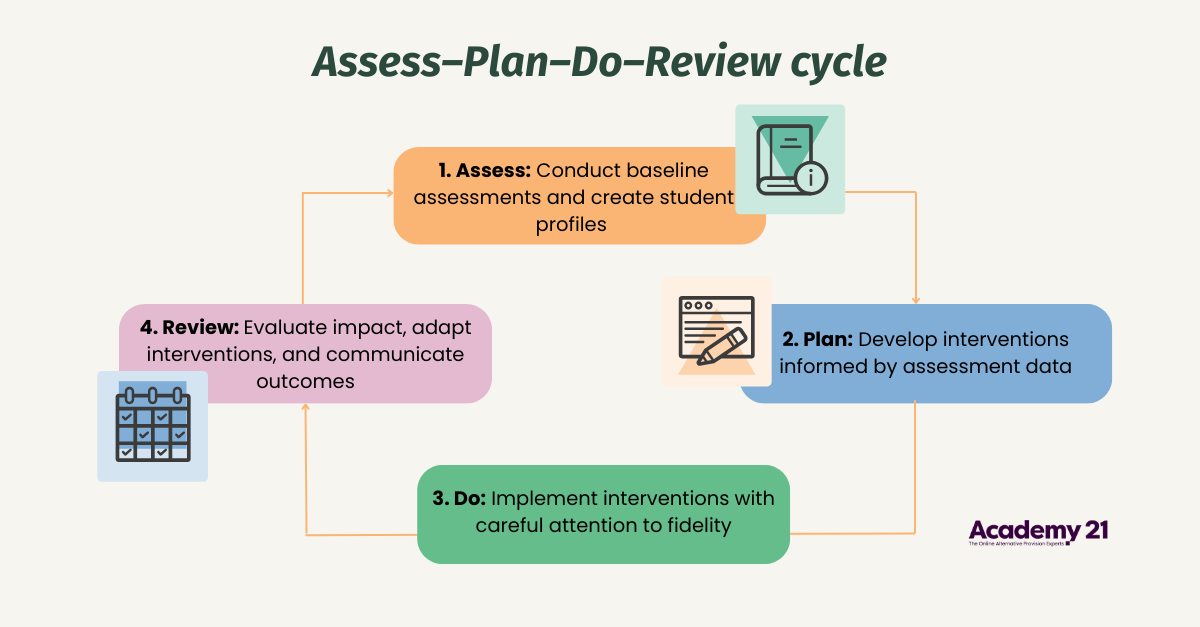What does your SEND Improvement Plan look like for this year?

A SEND improvement plan should be more than a requirement; it can be the framework that guides meaningful change for some of the most vulnerable learners in your setting. As the Inclusion in Practice Group have reported in their emerging insights that Academy21 was proud to contribute to, in the most inclusive settings:
“Leaders see inclusion as a core priority and principle across their settings, not a separate system. When responsibility is shared and guided by a clear ethos, schools align planning, development, and accountability to drive consistent, inclusive practice.”
This means planning for every area, activity and experience in your setting to be inclusive and as barrier free as possible for student with SEND. At Academy this means being inclusive by design.
Students in AP settings often present with complex needs, including gaps in prior learning, mental health or SEMH challenges, and disengagement from mainstream education. These factors make improvement planning a necessity, not just under the SEND Code of Practice, but also to ensure engagement, progress, and successful reintegration.
The stakes are high – most notably to make sure plans give young people the best chance to succeed and overcome barrier. But also, there is a growing focus from commissioners, Ofsted and new guidance that rightly expects robust evidence that AP settings are able to genuinely impacting learner outcomes.
Indeed, for some settings like multi-trusts, there is the added challenge of balancing consistency across sites with local flexibility so that each AP setting delivers high-quality, equitable support that reflects the community it serves.
Building an effective SEND and AP Improvement Plan: The core foundations
A strong improvement plan starts with knowing exactly what you want to achieve and how you’ll measure it. The best examples we see at Academy21 are where setting have asked themselves: Which learners need the most support? Which areas of provision are most inconsistent? What outcomes will this intervention actually improve?
When working across multiple AP settings either as Trust, part of a network of LA strategic lead, consistency is key. Ensure your plan is connected to other policy areas – safeguarding, behaviour, curriculum both informing those and embedded within them. The more inclusion becomes a default feature of other areas of school life, the easier implementation of you plan will be.
One tip we’ve seen work well is plan deliberate how policy will look in practise and model this relentlessly. For example, if your policy requires personalisation, what will this look like? Does this mean student profiles? If so, what is the template, who is responsible for completing them, when they’re updated, and how staff will use them to adapt their teaching. Be explicit in your planning – focus on the actions colleagues will undertake and don;t assume they will always know what to do!
Your plan should set concrete, measurable actions. Instead of saying “increase engagement from parents” define what that looks like: we will meet X % of parents/carers of students with SEND by Y date; we will conduct X number of parent/carer surveys by Y date; we will run X number of workshops on Y topics across the year. Build in short-cycle review points – for example, every six to eight weeks, so you can check whether interventions are working and adjust quickly.
The Assess–Plan–Do–Review cycle in AP
The assess–plan–do–review (APDR) cycle sits at the heart of SEND provision. In AP, it requires adaptation. Unlike mainstream schools, students in AP often have incomplete or inconsistent educational histories, making it harder to set baselines – this needs thought. The cycle can be broken down as follows:
- Assess: Conduct baseline assessments covering academic skills, SEMH indicators, attendance, and risk factors. Create profiles summarising needs.
- Plan: Develop interventions informed by assessment data. Include strategies for engagement, wellbeing, and academic development.
- Do: Implement interventions with careful attention to fidelity, ensuring staff are equipped and supported.
- Review: Evaluate impact, adapt interventions, and communicate outcomes to learners, parents, and relevant professionals.

For example, a student with a history of school non-attendance due to anxiety may initially engage due to the novelty of the setting. Without short-cycle reviews that highlight success and prepare for the known ‘pinch-points’, progress may plateau, and staff may miss early warning signs of disengagement. Regular reviews allow you to adjust support, adapt content, or involve parents more closely to maintain momentum.
If you are partnering with an external AP provider, it’s important to ensure they can adapt to your trust’s timelines and offer enough flexibility for frequent reviews and adjustments.
At Academy21, because we operate in a fully online environment, we can easily adjust lesson timings to fit your school’s schedule. But it isn’t just the timetable itself that we can adapt to: our programmes reflect what each individual student needs, whether it’s a short-term intervention or prolonged support. They are fully flexible, and we continuously report on engagement, progress, and wellbeing and our expert staff and yours can respond quickly to provide the effective support.
Sustaining engagement beyond the first term
Engagement in AP settings is often initially high but can drop as the novelty of the setting fades. That’s why you need to keep engagement front and centre in any SEND improvement plan:
- One way to do this is by including detail of how you will regularly review curriculum delivery. Has every subject reviewed the manner in which they deliver content and what they expect students to produce. This thinking should be continuous, for each teacher but also at a department level. Is each subject leader confident the ‘ask’ of each child is actually possible or rather has been scaffolded enough to make it happen.
- Student voice and choice are equally important features of a plan. When learners help shape their curriculum via choice, within required limits, they take ownership. We know teaching metacognitive strategies and providing students the opportunity to apply them can enhance learning considerable, so has choice been planned into your curriculum? And, how often do you ask students to feedback on their ownership and engagement. This can be quick and simple, but it should be in your planning.
- Finally, recognition of progress can make a huge difference. Celebrate achievements at every level, from attendance and behaviour improvements to small academic successes. Sharing these wins with families reinforces the link between effort and achievement, keeping students invested. At its heart it is normative, and the small wins compound to raise confidence so planning for how every teacher will do this is critical.
Embedding professional development
Your staff determine how effectively your SEND improvement plan is delivered. To make a real difference, link professional development directly to the improvement priorities.
Focus on practical skills that directly impact learners, such as trauma-informed approaches, SEMH interventions, relational practices, and literacy or numeracy strategies for students with learning needs. Standardise these approaches and coordinate CPD sessions across sites to maintain consistency.
Make sure to plan for staff support as well, using structured supervision and feedback to help staff reflect on their practice and make improvements.
At Academy21, we invest heavily in our teachers because we know that high-quality teaching drives student outcomes. For example, we host weekly CPD sessions, INSET weeks focused on collaborative learning, and opportunities for teachers to share best practice across subjects and sites.
We provide teachers with practical training and strategies that are tailored to their students and subjects. This includes using digital tools confidently, keeping students motivated and engaged, and adapting teaching methods to meet the needs of learners with SEND or SEMH challenges.
Monitoring, reviewing, and adapting
Progress tracking is critical. Monitor both quantitative data (attendance, participation, behaviour, academic progress, and SEMH measures) and qualitative insights from students, parents, and staff. Focusing on these areas helps you identify what’s working, where learners are struggling, and which interventions need adjustment.
A SEND improvement plan is only as effective as the impact it has on learners. For students who have experienced disengagement or gaps in learning, the right plan can improve engagement, academic progress, and readiness for reintegration. As a director managing multiple AP sites, your role is to make every strategy, intervention, and policy purposeful, measurable, and aligned across the trust.
Academy21 collaborates with hundreds of Multi-Academy Trusts and thousands of schools across England, providing DfE-accredited, high-quality online education from Key Stage 2 through to Key Stage 5. We work closely with your teams to adapt interventions, monitor progress, and facilitate reintegration, making every strategy in your plan actionable and impactful. Reach out to our team below if you would like to partner with us or learn more about what we do.



